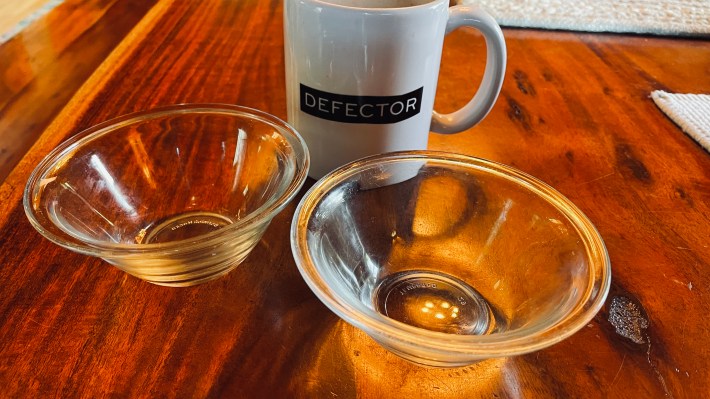It has come to my attention that there are those who believe that poaching eggs is difficult, or a delicate job; that supposedly "easy" methods for poaching eggs are lies; that in order to have a good poached egg, a normal person must seek the services of professional cooks. Valued friends believe this. Why, it could almost make you suspect that not everybody on earth has read and absorbed blogs I wrote nine years ago. Surely that's not the case!
Poaching eggs is not a difficult or especially delicate or fussy job. It is not more difficult or delicate or fussy than frying them over-easy; for that matter, it is not more difficult or delicate or fussy than making authentically good small-curd scrambled eggs. It is certainly far less delicate a job than soft-boiling, the egg preparation most similar in final product. Were I not a horribly self-indulgent writer with cripplingly scattered ADHD Brain, all the rest of this blog, which will demonstrate the ease of poaching eggs, could be two paragraphs, rather than 40,000. Oh well. Let's poach some eggs.
Here are some things that you will need. You will not need a lot of things! Let's start with the inedible stuff.
You will need a pot. The ideal pot shape for poaching eggs, if you want perfect teardrop-shaped eggs and want to be able to poach a handful of them at a time, is that of a pasta pot: Tall, and relatively narrow, so that it can have a deep column of very hot water in it and when you pour each egg into the top of this column of water, the egg can spend longer falling down through it before hitting bottom. If the pasta pot has a thick, heavy bottom, this is even better, bordering on essential, as it will help the pot and thus the water remain very hot even when they suddenly have several cold eggs descending through them.
But maybe you do not have a pasta pot! Maybe you have a pasta pot but it is caked with gunk from last night's pasta extravaganza which you improvidently declined cleaning up before going to bed. That is OK. Use your biggest pot, or your only pot, so long as it is a pot and not a skillet or a griddle or an old boot you found in the gutter.
As long as you have some kind of pot of the sort you'd use to boil water, you can poach some fine poached eggs. The eggs in that photo up there were poached in a small two-quart stainless steel saucepan—the everyday-use kind in which you probably have cooked instant ramen before in your life—precisely so that I could make this point: You do not need a huge pasta pot to succeed at poaching eggs. (They were wonderful, thank you for asking.)
You will need, or anyway will certainly benefit from having, a slotted spoon or even just a reasonably large soup soon, for scooping the eggs out of the water when they are done cooking. (This could also be a long-handled mesh strainer, or a wire spider.) If you are using a large pasta pot for poaching your eggs, this should probably be something with a longer handle than your typical cereal spoon, unless you are Pee-Wee Herman. The eggs might bob up to the top of the pot as they cook, but also they might languish in the middle depths, out of the reach of the kind of spoon you use for stirring tea daintily. Be warned!
You will need some type of small vessel for cracking the eggs into before they go in the pot. Here I am talking about, like, a little ramekin, or those mis-en-place bowls they sell in sets of four in the kitchen-tool sections of your local big-box or home-goods store, or a mug, or a small water glass. You get the idea. Something small and relatively shallow, so that an egg can be cracked into it without the egg's insides spending a lot of time accelerating through the air.
I used lil' mis-en-place bowls:

The reasons to use these instead of cracking the eggs straight into the water are at least twofold, and possibly morefold if I happen to think of any others while typing the next couple of sentences. For one thing, you are working with boiling water here: If you crack an egg straight into the pot from above, the egg is going to hit the surface of that water kind of hard, and it's going to splash boiling water on your wrists, which sucks. Cracking the egg into a little vessel first allows you to hold the vessel right down at the surface of the water and gently sliiiide the egg into the water, so that there is no splash at all. For another thing, cracking the egg into a little bowl first allows you to view and approve the egg before it goes into the water, so that you can see whether it has any shards of shell in it or spots of blood on it, and more crucially whether the yolk is intact. If you drop an egg with a broken yolk into the water, you're just going to have a gross pot full of congealed yolk bits instead of a poached egg.
If you have more than one of whatever you're using, or more than one small vessel that can be press-ganged into service for this, that's great: You can crack an egg into each one, and that simplifies the work of getting them into the boiling water as close to simultaneously as you can manage. Otherwise—if you don't have multiple small vessels, or simply do not wish to compound the dishwashing—you will have to crack one egg in the solitary vessel, plop it into the water, quickly crack another egg into the empty vessel, plop that one in the water, and repeat. That's fine! I've done it that way a zillion times. It's just easier if you can get all or most of the egg-cracking out of the way before you start putting eggs in water.
You will need a plate (not the one you'll be eating off of, though you'll need that too). You will need a clean kitchen towel of the sort that will not lose a bunch of fibers onto, say, a wet poached egg briefly brought into contact with it, or, failing that, a few layers of paper towels. Whatever type of towel or cloth you are using, place it onto the plate.
OK I think that's it for the tools and supplies. You will also need some ingredients.
You will need some eggs. Eggs come in sizes, down at your supermarket: Large, extra-large, jumbo, possibly some others I am not remembering. The biggest eggs will take a little longer to poach than the smaller ones, or will be a little bit less cooked inside if you poach them the way you poach smaller eggs; none of the differences here are all that big, either in cooking time or in end result. Still, for now, I recommend large or extra-large eggs. The eggs in that photo up there are extra-large eggs.
I also recommend the freshest eggs you can find. A fresh egg's yolk is more centered than the yolk in an older egg, and thus will heat more evenly and predictably; its white will hold its shape much better, rather than drifting around in the hot water and coming out ragged. Keep the eggs cold until the water is ready for them; this will help the yolk stay runny while the white cooks.
Then there is the question of how many eggs to poach. I think that you should plan on poaching two eggs per adult (or adolescent with an adult-sized appetite) who will be eating the eggs you poach. I also think that, if you are planning on feeding more than like four or five people, you should go ahead and think of something else to cook instead of poaching eggs, for all the same reasons why frying eggs for half a dozen people would be a pain in the ass: You are not a short-order cook, and your home is not a greasy spoon diner, unless you are and it is, in which case why are you reading this blog instead of tending to the corned beef hash.
You will need some regular tap water. I don't know that the water quite qualifies as an "ingredient" here. It's more like a cooking medium. It isn't a dang tool in any case. If you are using a big pasta pot (or another shape of authentically huge pot), fill it like you would to cook a pound of bucatini in there; if you are using a smaller pot, fill it so that the water comes up to, oh, let's say an inch below the rim. The idea is to have, at the very least, several inches of depth for the eggs to plunge through on their way to boiling hell.
You will need some small amount of plain white vinegar. Not a lot! Use a tablespoon of vinegar for each two quarts of water you're using.
There's some disagreement among culinary types over why to do this. Some (like the Culinary Institute of America) say that the vinegar causes the egg proteins to set faster, resulting in a lovelier shape and a more evenly cooked egg and less of the white drifting away while the egg cooks. Others say this is baloney—yet still add vinegar to the poaching water, because it reacts with the alkaline egg white to form tiny bubbles in and on the surface of the egg, which increases the egg's buoyancy, which causes it to bob up from the bottom of the pot and cook more evenly. You do not need to know, or even wonder, which of the two sides is right, since ultimately what they're disagreeing over is the scientific reason for a phenomenon neither side denies, which is that eggs poached in slightly vinegary water are shapelier and more evenly cooked than those cooked in plain water.
Some poached egg recipes call for also salting the water. In hot, salty water, the eggs will have greater buoyancy, and will float higher as they cook. I don't give a damn about that. If you do, maybe add a teaspoon of salt for each quart of water you're using. But you will need some salt either way, for seasoning the eggs, and also some black pepper, ideally in a grinder, which you will grind freshly over each egg.
If you are interested in making exactly the dish appearing in the photograph at the top of this endless blog, then you will also need to toast a slice of whole-wheat bread, spread some good butter on it, and give a quick chop to a few fresh chives.
OK! Let's cook! Let's poach these dang eggs. You'll love how easy it is.
Bring the slightly vinegary water to a boil on the stovetop. You can put a lid over it to make this happen faster. When it has just come to a gentle boil, grab the eggs from the fridge, crack one egg into each of however many little vessels you're using, and slide those suckers into the water. If you are using a genuinely big pot (and have enough little vessels to make this possible, or feel like working very fast to reuse a small number of them), you can do up to half a dozen eggs at once; if you are using a little two-quart saucepan, don't do more than two at a time, or the water will cool too much as soon as the eggs hit it, and it'll throw off the timing. Set a timer for four minutes. While you wait, I'll talk at you.
Some poached egg preparations call for a trick where you swirl the water into a vortex with a spoon just before adding the egg; the theory there is that the spinning motion the egg will undergo as it plummets through the water will help it to form a nice teardrop shape. I like this idea, like just in concept. My inner little kid likes swirling water into vortexes, and also my outer washed old piece of crap. Possibly you have figured out by now that if I were endorsing this method, I would have said so before telling you to slide the eggs into the water.
I am sad to say that in my experience the vortex trick does not make an appreciable difference in the poached egg's ultimate shape, though it does make the process of poaching an egg more complicated and messy. Don't bother, for the principal reason that you simply don't have to: If the water is deep and hot and the egg fresh, it will take on a nice shape just from falling through that column of water.
When the timer goes off, extract the eggs from the water one at a time by lifting them gently out with your slotted spoon or wire spider or whatever. Gently, once again gently, lower each egg onto the absorbent cloth or towel you put on the plate a while ago, so that it can blot some of the excess water off of the egg. If you have more eggs to poach, poach them; otherwise, that was it. That was the whole thing. That was poaching eggs. You placed them in boiling water, you set a timer, and then you removed them from the water.
The eggs are ready to eat. To turn them into the breakfast from the photo up there, simply plop two of them on the buttered toast, sprinkle them lightly with salt, grind some black pepper on there, and scatter those pretty little chives over them. If you start in on how eating poached eggs is hard and only restaurant chefs can do it properly, I am gonna fucking flip out.







